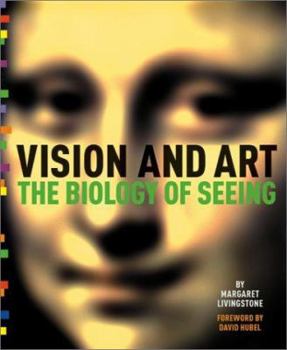Vision and Art: The Biology of Seeing
Select Format
Select Condition 
Book Overview
The updated and expanded edition of Harvard professor Margaret Livingstone's Vision and Art, which successfully bridged the gap between science and art, exploring how great painters fool the brain:... This description may be from another edition of this product.
Format:Hardcover
Language:English
ISBN:0810904063
ISBN13:9780810904064
Release Date:May 2002
Publisher:Harry N. Abrams
Length:208 Pages
Weight:2.92 lbs.
Dimensions:0.9" x 9.5" x 11.4"
Age Range:13 years and up
Grade Range:Grade 8 to Postsecondary
Customer Reviews
5 ratings
Vision and Art by Margaret S. Livingstone
Published by Thriftbooks.com User , 16 years ago
This is a most outstanding work on the anatomic and physiologic concepts underlying visual perception. It is aimed at any interested layman and should be required reading for visual artists, neuro-physiologists and any vision science practitioners. It requires attentive reading initially, but the extent of its insights are breathtakingly rewarding for those efforts. It is a visually stunning book that is the product of an inquiring and perceptive mind who is a senior member of the neuro-physiology faculty at Harvard. As an ophthalmologist and vision scientist-educator, I have strongly recommended it to trainees and older colleagues alike. Try it - you'll like it. MAH
Vision and Photography
Published by Thriftbooks.com User , 19 years ago
This is a book that every teacher of photography and serious photographer should read and study and re-read. Although the book contains no photographic examples, there are plenty of examples in famous paintings to support the visual research Dr. Livingtson so clearly writes about. The examples in paintings are easily transferable to a number of familiar and famous photographs. Ever wonder what Ansel Adams and Edward Weston were so successful with the black-and-white photographs but not with their color photographs? I have, and her book has provided me with insights into this and other photographic practices.
Shows you how you see and how you paint
Published by Thriftbooks.com User , 20 years ago
Margaret Livingstone has produced a book so very useful to visual artists that it may, in its density of ideas, seem definitive rather than evocative. But evocative it is. As we learn from studying it, Livingstone's book offers implications that may be developed by any artist who reads it in almost any direction. One might take as an example the very rich Chapter 8, with its notions of luminance as a balance for the salience, or pushiness of certain colors - how Leonardo handled it, how Ingres handled it, and how today's painter or digital image maker might go even further. The size and shape of the book allow for illustrations that work on the eye at the right scale. And there is an overall visual loudness to the book that is jarring and satisfying. The author gets to the structure of our visual systems, makes them very clear, and tells us things that are lasting and verifiable. Her spirit of personal experimentation shows in the book, and makes us think that looking inquisitively at the world will pay off.
Fascinating Science of Visual Art
Published by Thriftbooks.com User , 21 years ago
Some teasers on the back cover:"Why do Claude Monet's fields of flowers seem to wave in the breeze?""What is the secret of Mona Lisa's smile?"The first two chapters cover some scientific fundamentals- how light and the human vision works. While this is all very scientific, every effort is made to make it understandable, with plenty of full-color diagrams illustrating the concepts. While these 2 chapters are not the easiest to read, they're not rocket science either, and provide a valuable foundation for the rest of the book. Not essential but VERY useful.Things start to get interesting toward the end of the 2nd chapter, when we start to understand what a red/green colorblind person sees. But the best stuff starts to come in the third chapter ("Luminance and Night Vision"). Plenty of interesting illustrations are provided in this chapter (like red cherries in a blue bowl, where the cherries appear brighter or darker than the bowl depending on the ambient light, or flickering polkadots), and continues until the rest of a book, making it a truly fascinating read.Oh, and the explanation on Mona Lisa's enigmatic smile is very convincing.I definitely recommend this book to anyone interested in both visual art and science.I also recommend it to anyone who's interested in science and how things work- you'll appreciate some art pieces a lot more after reading this book.
First rate science meets oil painting.
Published by Thriftbooks.com User , 22 years ago
This is a really neat book but the title is a misleading. It doesn't cover all visual art but concentrates on oil painting. The author is a neurophysiologist at Havard Med who can actually write intelligbly, entertainingly and accessibly about her field and how it intersects with 2 dimensional art. It is not an easy read. The book is chock full of visual illusions, detailed illustrations, carefully chosen paintings from the last 500 years and quotations from the scientists who have studied light, color and vision. The last chapter covers electronic media in the form of computer and TV screens and was particularly good but seemed to lack integration with the rest of the manuscript. Overall, this book is delighfully dense. Take some time and savor it.





